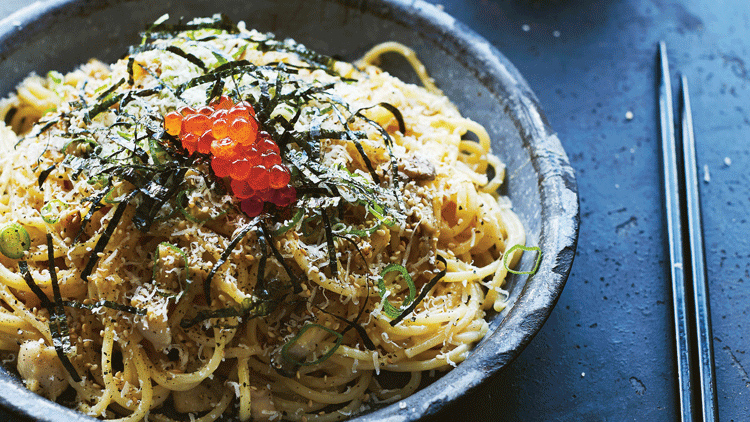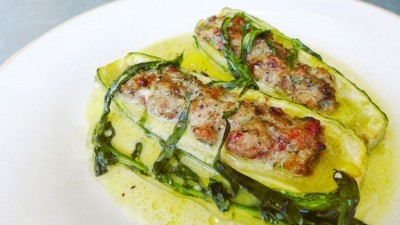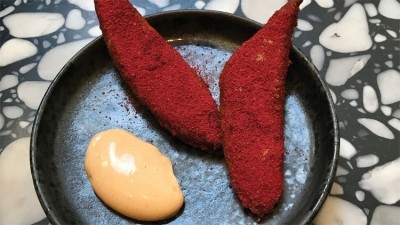Masterclass: Tim Anderson's Japanese-style carbonara

The Japanese influence in high-end Western restaurants is a modern-day phenomenon: buzzwords like yuzu, miso, shiso, dashi and umeboshi liberally pepper Michelin-starred menus throughout Europe and North America, and, these days, any chef worth his or her moshio salt understands the concept of umami.
It is not all one-way traffic, however. Japan has been borrowing and adapting dishes from other cultures for centuries. The Portuguese introduced tempura, the British took curry from India to Japan, and hamburgers can be found on every Tokyo street corner.
Tim Anderson, the American who won MasterChef in 2011 and is now chef-proprietor of Nanban, in Brixton, is also a scholar of Japanese cuisine, studying it at college, then moving to Japan for two years to investigate it further.
“There’s a whole class of Japanese-adapted Western dishes called wafu,” he explains. “They’re recognised as foreign in origin, but they are so popular and widespread that they might as well be Japanese. Wafu steak, for instance, often served with mashed daikon and onion sauce, or mochi wafu pizza, topped with chewy rice cakes that go gooey with the cheese: both are just as Japanese as sushi to me. Considering how few foreigners are there, they are very open-minded about food, and happy to borrow from other cultures if they like the flavours.”
Especially pasta, “which is invariably spaghetti” – wheatflour noodles, ramen especially, are a Japanese staple, so it kind of makes sense – although there are a few penne dishes, too. The basic preparation would be with butter and soy sauce, with garlic, mushrooms and spring onions, maybe. Another example is mentaiko pasta, which uses pollock roe cured with chilli to flavour a buttery sauce: the flavour of mentaiko is like a combination of Italian bottarga and chilli.
“At home, the Japanese use a surprising amount of prepared stocks and sauces, but they are usually of a very high quality: they will use dashi powder, for example, but it’s not like using an Oxo cube. And quick suppers are often prepared with a pre-made pasta sauce.”
Cheese is a more alien concept but certain types are catching on. “Umami-rich parmesan is very sympathetic to the Japanese palate, although they hate blue cheese. There’s a home-grown mild cheese, which is good for melting and not much else, but the Japanese think of Italy and France as producing the best cheese.”
His recipe for carbonara uses several ingredients plus parmesan to provide umami: “There are three components of umami. There are glutamates, which you find in soy; inosinates, from dried fish or cured meats; and guanylates, in dried vegetables and mushrooms. You can find them all on the back of a can of Pringles.”
Brixton-based dropper of umami bombs Tim Anderson
The ‘umami bomb’ that reverberates through his carbonara comes from mushrooms, white (or pale red) miso, instant dashi stock, nori and parmesan. He tops it with a spoonful of ikura, salmon roe: “you don’t have to use it, but I think it really makes the dish.”
In Italy, mixing cheese and seafood is almost heretical in a pasta dish “but there aren’t really any rules with Japanese pasta,” insists Anderson, who says its remarkable how well Japanese flavours work when stirred through spaghetti.”
The sauce also contains sake which, unlike the white wine in a classic French or Italian sauce, is not boiled away: it just slackens the sauce and adds a distinctive, gently alcoholic perfume to the finished dish. The carbonara element is the egg, which is whisked with dashi, miso and lemon juice, then stirred into the spaghetti at the last moment. “Be quick with this,” advises Anderson, “so the residual heat from the pasta cooks the eggs and thickens the sauce, or you will end up with clumps of scrambled egg.”
Nanban is a remarkable restaurant, taking the produce of Brixton Market and treating it in a thoroughly Japanese fashion. As a symbol of the new global gastronomy, there cannot be many better examples than an American chef cooking a Japanese version of an Italian dish… in south London.
Japanese carbonara, by Tim Anderson (serves 4)
Ingredients
50g unsalted butter
100g onion, finely chopped
200g oyster or shiitake mushrooms, stems removed and thinly sliced
4 garlic cloves, grated or very finely chopped
2 tablespoons sake
1 tsp freshly ground black pepper
4 tbsp white miso
4 tbsp dashi
2 eggs, beaten
Juice of half a lemon
500g dried spaghetti
Toasted sesame seeds
Salt
½ sheet nori, cut into fine shreds with scissors
30g parmesan or pecorino
2 spring onions, finely sliced, or 1 tbsp chopped chives
60g ikura (salmon roe), optional
Method
1. Melt the butter in a large frying pan and add the onion and mushrooms. Fry until the onion and mushrooms are just golden brown, then add the garlic and cook until soft. Add the sake and black pepper and stir through. Reduce the heat to low.
2. In a bowl, whisk together the miso, dashi, eggs and lemon juice, ensuring that no lumps of miso remain. Cook the pasta at a rolling boil to your liking, then drain well and return to the pan.
3. Add the onions and mushrooms and the miso-egg mixture, then stir through quickly until the heat of the spaghetti cooks the egg and thickens the sauce. Taste, and adjust the seasoning as needed.
4. Garnish with sesame seeds, the shredded nori, parmesan and spring onions or chives, and a dollop of ikura, if using, in the middle, and serve immediately.
Adapted from Japaneasy, by Tim Anderson, Hardie Grant, £20




















